The Intel SSD 660p SSD Review: QLC NAND Arrives For Consumer SSDs
by Billy Tallis on August 7, 2018 11:00 AM ESTMixed Random Performance
Our test of mixed random reads and writes covers mixes varying from pure reads to pure writes at 10% increments. Each mix is tested for up to 1 minute or 32GB of data transferred. The test is conducted with a queue depth of 4, and is limited to a 64GB span of the drive. In between each mix, the drive is given idle time of up to one minute so that the overall duty cycle is 50%.
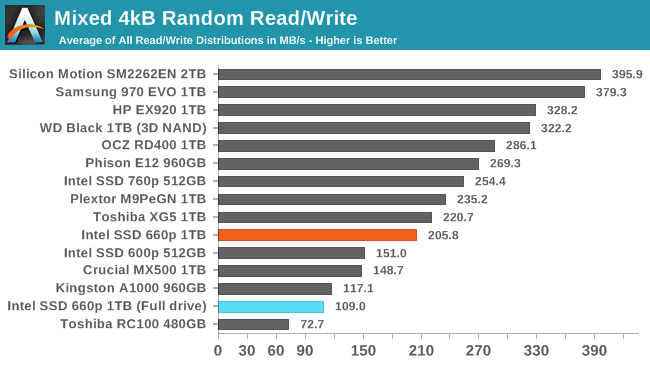
The mixed random I/O performance of the Intel SSD 660p is clearly above the other low-end NVMe drives we've tested, or the Crucial MX500 SATA drive. It scores closer to a mid-range NVMe SSD. After filling the drive, performance is cut in half, leaving it performing near low-end NVMe drives like the Phison E8-based Kingston A1000 and below the MX500.
 |
|||||||||
| Power Efficiency in MB/s/W | Average Power in W | ||||||||
The power efficiency of the 660p during the mixed random I/O test is unimpressive but doesn't stand out as being significantly worse that other low-end NVMe drives even when the test is run on a full drive.
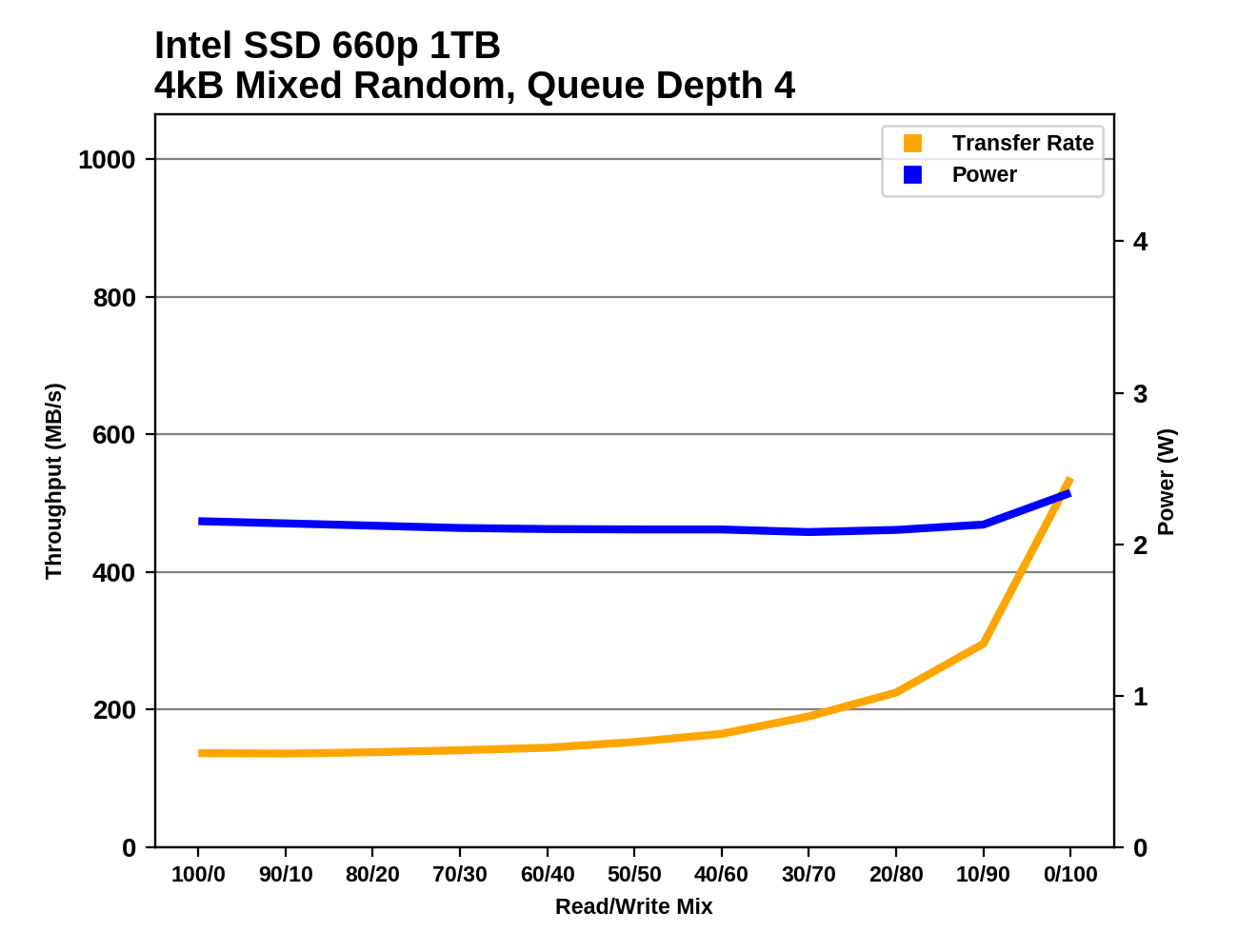 |
|||||||||
The Intel SSD 660p shows very slow performance growth throughout most of the test, but it picks up speed reasonably well toward the end as the workload shifts toward pure writes, and the SLC cache handles things well. When the drive is full, the reduced capacity of the SLC cache prevents speed from increasing much.
Mixed Sequential Performance
Our test of mixed sequential reads and writes differs from the mixed random I/O test by performing 128kB sequential accesses rather than 4kB accesses at random locations, and the sequential test is conducted at queue depth 1. The range of mixes tested is the same, and the timing and limits on data transfers are also the same as above.
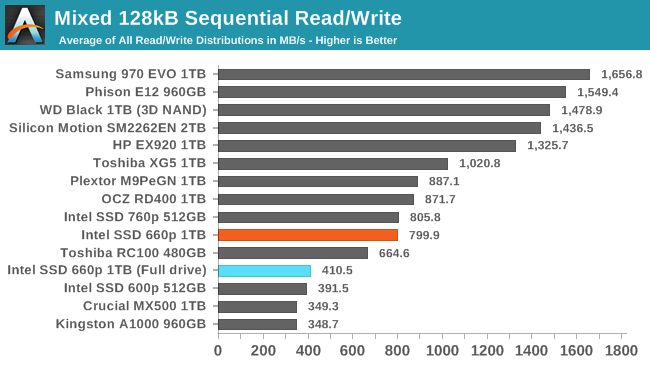
The Intel SSD 660p performs better than other entry-level NVMe SSDs or SATA drives when the mixed sequential I/O test is run on a mostly empty drive with a large SLC cache. After the drive is filled, performance drops down to slightly ahead of the 600p and Crucial MX500.
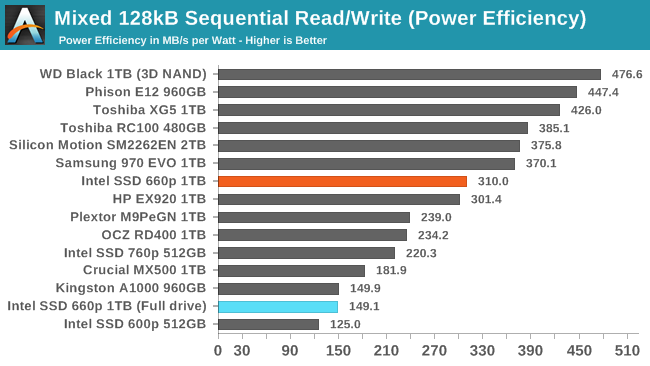 |
|||||||||
| Power Efficiency in MB/s/W | Average Power in W | ||||||||
The power efficiency of the Intel SSD 660p during the mixed sequential I/O test is decent when operating entirely out of the SLC cache, and on par with most other low-end NVMe drives when the 660p is full.
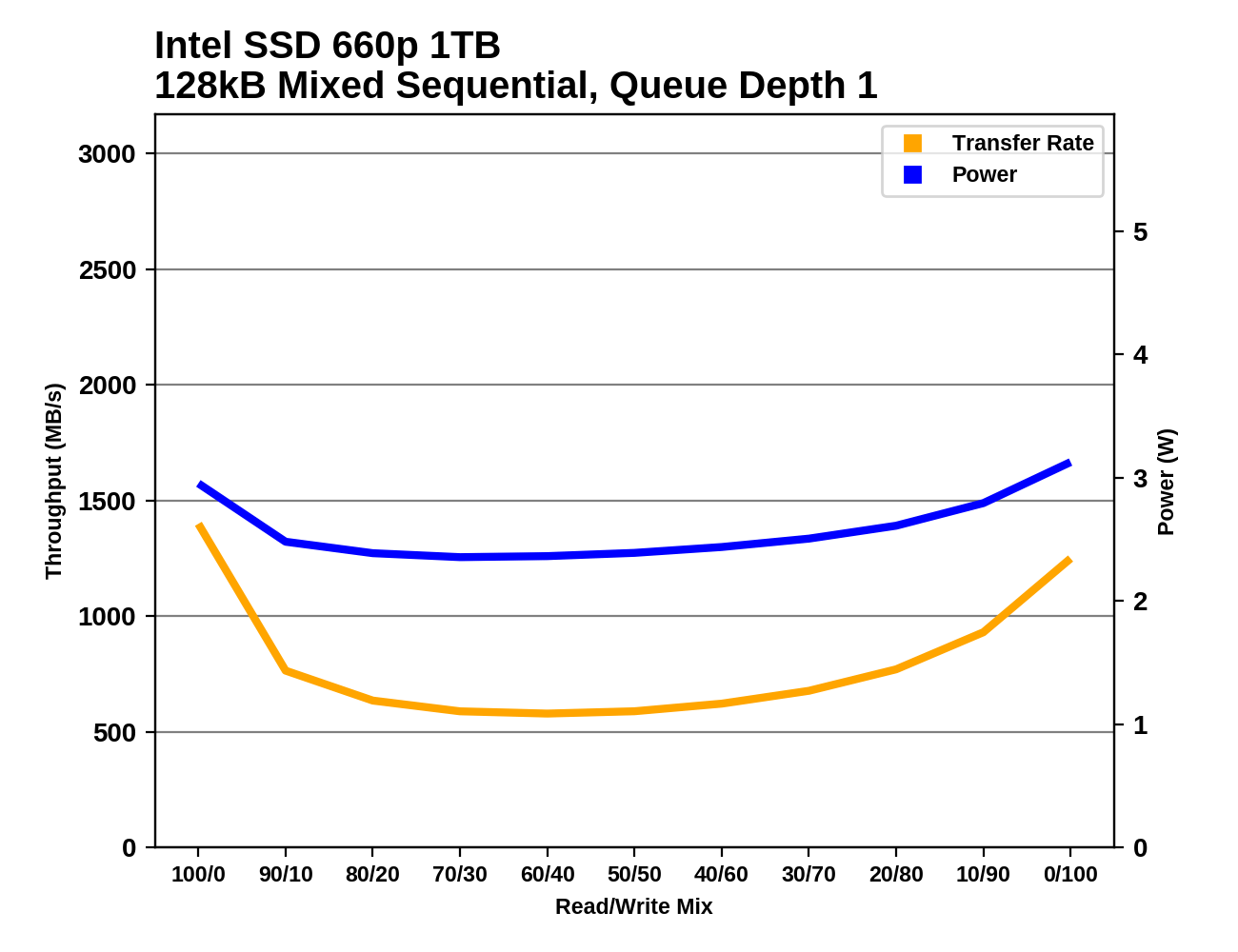 |
|||||||||
When the test is run on a mostly-empty 660p the performance shows a very typical bathtub curve and no sign of the SLC cache running out. When the drive is full, performance decreases steadily as the proportion of writes increases.










86 Comments
View All Comments
limitedaccess - Tuesday, August 7, 2018 - link
SSD reviewers need to look into testing data retention and related performance loss. Write endurance is misleading.Ryan Smith - Tuesday, August 7, 2018 - link
It's definitely a trust-but-verify situation, and is something we're going to be looking into for the 660p and other early QLC drives.Besides the fact that we only had limited hands-on time with this drive ahead of the embargo and FMS, it's going to take a long time to test the drive's longevity. Even with 24/7 writing, with a sustained 100MB/sec write rate you're looking at only around 8TB written/day. Which means you're looking at weeks or months to exhaust the smallest drive.
eastcoast_pete - Tuesday, August 7, 2018 - link
Hi Ryan and Billie,I second the questions by limitedaccess and npz, also on data retention in cold storage. Now, about Ryan's answer: I don't expect you guys to be able to torture every drive for months on end until it dies, but, is there any way to first test the drive, then run continuous writes/rewrites for seven days non-stop, and then re-do some core tests to see if there are any signs or even hints of deterioration? The issue I have with most tests is that they are all done on virgin drives with zero hours on them, which is a best-case scenario. Any decent drive should be good as new after only 7 days (168 hours) of intensive read/write stress. If it's still as good as when you first tested it, I believe that would bode well for possible longevity. Conversely, if any drive shows even mild deterioration after only a week of intense use, I'd really like to know, so I can stay away.
Any chance for that or something similar?
JoeyJoJo123 - Tuesday, August 7, 2018 - link
>and then re-do some core tests to see if there are any signs or even hints of deterioration?That's not how solid state devices work. They're either working or they're not. And even if they're dead, that's not to say anything that it was indeed the nand flash that deteriorated beyond repair, it could've been the controller or even the port the SSD was connected that got hosed.
Literally testing a single drive says absolutely nothing at all about the expected lifespan of your single drive. This is why mass aggregate reliability ratings from people like Backblaze is important. They buy enough bulk drives that they can actually average out the failure rates and get reasonable real world reliability numbers of the the drives used in hot and vibration-prone server rack environments.
Anandtech could test one drive and say "Well it worked when we first plugged it in, and when we rebooted, the review sample we got no longer worked. I guess it was a bad sample" or "Well, we stress tested it for 4 weeks under a constant mixed read/write load, and the SMART readings show that everything is absolutely perfect, we can extrapolate that no drive of this particular series will never _ever_ fail for any reason whatsoever until the heat death of the universe". Either way, both are completely anecdotal evidence, neither can have any real conclusive evidence found due to the sample size of ONE drive, and does nothing but possibly kill the storage drive off prematurely for the sake of idiots salivating over elusive real world endurance rating numbers when in reality IT REALLY DOESN'T MATTER TO YOU.
Are you a standard home consumer? Yes.
And you're considering purchasing this drive that's designed and marketed towards home consumers (ie: this is not a data center priced or marketed product)?: Yes.
Are you using it under normal home consumer workloads (ie: you're not reading/writing hundreds of MB/s 24/7 for years on end)? Yes.
Then you have nothing to worry about. If the drive dies, then you call up/email the manufacturer and get warranty replacement for your drive. And chances are, your drives will likely be useless due to ever faster and more spacious storage options in the future than they will fail. I got a basically worthless 80GB SATA 2 (near first gen) SSD that's neither fast enough to really use as a boot drive nor spacious enough to be used anywhere else. If anything the NAND on that early model should be dead, but it's not, and chances are the endurance ratings are highly pessimistic of their actual death as seen in the ARS Technica report where Lee Hutchinson stressed SSDs 24/7 for ~18 months before they died.
eastcoast_pete - Tuesday, August 7, 2018 - link
Firstly, thanks for calling me one of the "idiots salivating over elusive real world endurance rating numbers". I guess it takes one to know one, or think you found one. Second, I am quite aware of the need to have a sufficient sample size to make any inference to the real world. And third, I asked the question because this is new NAND tech (QLC), and I believe it doesn't hurt to put the test sample that the manufacturer sends through its paces for a while, because if that shows any sign of performance deterioration after a week or so of intense use, it doesn't bode well for the maturity of the tech and/or the in-house QC.And, your last comment about your 80 GB near first gen drive shows your own ignorance. Most/maybe all of those early SSDs were SLC NAND, and came with large overprovisioning, and yes, they are very hard to kill. This new QLC technology is, well, new, so yes I would like to see some stress testing done, just to see if the assumption that it's all just fine holds, at least for the drive the manufacturer provided.
Oxford Guy - Tuesday, August 7, 2018 - link
If a product ships with a defect that is shared by all of its kind then only one unit is needed to expose it.mapesdhs - Wednesday, August 8, 2018 - link
Proof by negation, good point. :)Spunjji - Wednesday, August 8, 2018 - link
That's a big if, though. If say 80% of them do and Anandtech gets the one that doesn't, then...2nd gen OCZ Sandforce drives were well reviewed when they first came out.
Oxford Guy - Friday, August 10, 2018 - link
"2nd gen OCZ Sandforce drives were well reviewed when they first came out."That's because OCZ pulled a bait and switch, switching from 32-bit NAND, which the controller was designed for, to 64-bit NAND. The 240 GB model with 64-bit NAND, in particular, had terrible bricking problems.
Beyond that, there should have been pressure on Sandforce's decision to brick SSDs "to protect their firmware IP" rather than putting users' data first. Even prior to the severe reliability problems being exposed, that should have been looked at. But, there is generally so much passivity and deference in the tech press.
Oxford Guy - Friday, August 10, 2018 - link
This example shows why it's important for the tech press to not merely evaluate the stuff they're given but go out and get products later, after the initial review cycle. It's very interesting to see the stealth downgrades that happen.The Lenovo S-10 netbook was praised by reviewers for having a matte screen. The matte screen, though, was replaced by a cheaper-to-make glossy later. Did Lenovo call the machine with a glossy screen the S-11? Nope!
Sapphire, I just discovered, got lots of reviewer hype for its vapor chamber Vega cooler, only to replace the models with those. The difference? The ones with the vapor chamber are, so conveniently, "limited edition". Yet, people have found that the messaging about the difference has been far from clear, not just on Sapphire's website but also on some review sites. It's very convenient to pull this kind of bait and switch. Send reviewers a better product then sell customers something that seems exactly the same but which is clearly inferior.